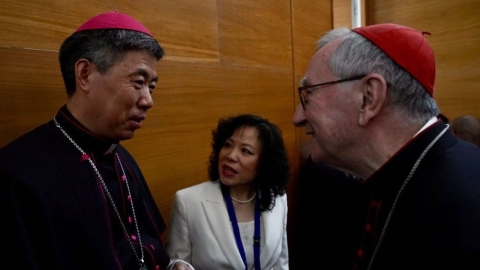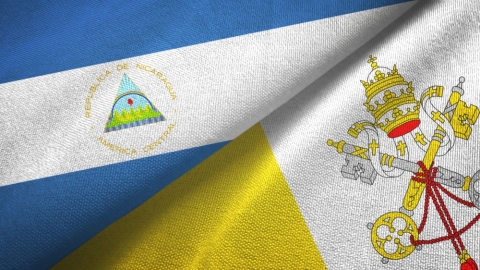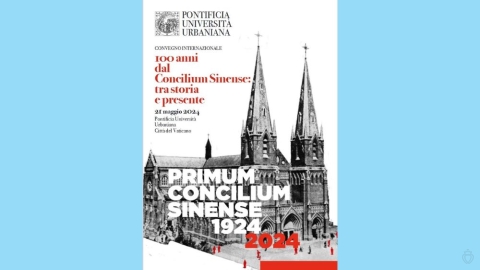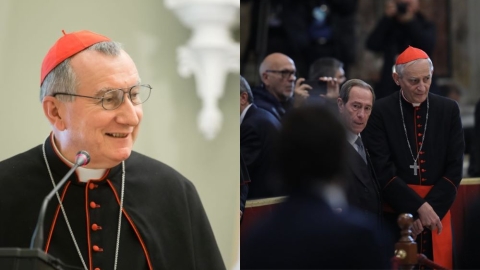Behind the Scenes of the Synod’s Second Week

Bishop Shane Mackinlay and Professor Renee Köhler-Ryan
Australians occupy the spotlight for a week which saw the most sensitive questions get examined, against a backdrop of tensions that the daily press review revealed. In a grand finale, a very political prayer for migrants before the Synod was given in St. Peter’s Square on the afternoon of October 19.
The Synod’s second week, which just came to a close, highlighted the role played by two progressive Australian personalities: Renee Köhler-Ryan, professor at the University of Notre Dame (Australia); and Shane Mackinlay, bishop of Sandhurst, who was charged by the Supreme Pontiff to take part in the final revision of the synodal synthesis document.
Both were delighted, during a press review, with the fact that the Synod had broached the sensitive topic of the diaconal ordination of women: “I am happy that the subject is on the table; it is important that this be discussed at the level of the universal Church,” stated the bishop of Sandhurst.
Because of the chosen methodology, we do not have at our disposal any exact indication of the degree of support existing for propositions aiming to progress on the theme of the ordination of women, nor if these propositions came from clerics or laypeople present at the meetings. What is certain is that the discussions this week illustrated the synodal principle—repeated frequently—according to which “anything can be said and must be written, for it could be inspired by the Holy Spirit.”
To put an end to persistent rumors of a biased Synod, Fr. Vimal Tirimanna—moral theologian and theological advisor of the Synod—was urgently dispatched on October 16 to journalists, to explain that this Synod is “not a private agenda of Pope Francis” but is “a continuation of Vatican II.” This clarification says a lot about the fact that the organizers are well aware that they are walking on eggshells.
That is what Bishop Mackinlay indirectly confirms: “At the end of each group meeting, we are not asked to vote to determine if we agree with all that is written in the report but rather if the report is an accurate representation of the group’s discussion.” This admission shows the fragility of the synodal process.
Zdenek Wasserbauer, auxiliary bishop of Prague, also points out the differences of opinion that emerge: “what matters is that no one gets angry when a different opinion is expressed, and each can freely express his own belief, his own conviction.”
Sister Patricia Murray, Secretary General of the International Union of Superiors General (UISG), recognized, between 2 meetings, that “very diverse opinions” had been expressed and that “certain tensions” had arisen.
The excitement was more tangible than ever in the Synod halls on October 17; on that day, the participants discussed episcopal functions and the possibility of laypeople interfering in the nomination of prelates. So, when will the election of a bishop by global vote be completed via smartphone?
To release some tension from the synodal pressure cooker, there is nothing more beneficial than a breath of fresh air: on October 19, the Holy Father again took charge, in person, calling all the participants to a “moment of prayer for migrants and refugees” in St. Peter’s Square, closed to tourists for the occasion.
In front of 500 people, Pope Francis defended the cause of the migrants “robbed, stripped and beaten along the way,” just like “the traveller in the parable” of the Good Samaritan.
The Pontiff took a stance as political as it was utopian, demanding the expansion of “regular migration channels,” with the traditional minute of silence which followed, in memory of migrants and refugees “who lost their lives along the different migration routes, and those who have been exploited or enslaved.”
Articles Liés
(Fonti: Catholic weekly/National Catholic Register/Crux – FSSPX.Actualités)
Immagine 1 : Diocèse de Sanhurst
Immagine 2 : World Economic Forum





